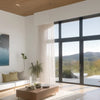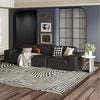Marble vs. Sintered Stone: Optimal Material Choices for Malaysian Interior Design

Introduction
In interior design within Malaysia, the choice between marble and sintered stone is a prevalent topic of interest. Each material possesses its own set of advantages and disadvantages. This article aims to provide a detailed comparison of their characteristics and suitability for various applications, enabling consumers to make an informed decision.

Marble Characteristics and Applications for High-End Designs
Natural Aesthetic and Uniqueness
- Natural Beauty: Marble features unique natural veining and colors, with each slab being one-of-a-kind. This natural beauty adds an artistic and luxurious touch to high-end interior design, symbolizing status and prestige. For example, the Mandarin Oriental Hotel in Malaysia uses Panda White Marble in its lobby and public areas, leveraging the marble’s distinct patterns and colors to create an elegant and sophisticated atmosphere .
- Aesthetic Value: Many high-end clients and designers appreciate marble's uniqueness and natural beauty, especially in luxury residences and high-end commercial spaces. The St. Regis Residences in Kuala Lumpur use Italian marble to highlight their high-end positioning and distinctive taste.

High-End Market
- Luxury Symbol: Due to its rarity and high cost, marble is often seen as a symbol of luxury and status, attracting affluent clients and those seeking high-quality aesthetics. For instance, the Four Seasons Hotel uses Calacatta Marble in its suites and public areas to enhance the overall luxurious feel and visual impact.
Daily Maintenance
- Requires More Care: Marble is relatively soft, prone to scratching, and porous, requiring regular sealing and professional cleaning to prevent stains and damage. Many high-end restaurants, such as The Ritz-Carlton, regularly perform professional maintenance on their marble surfaces to maintain their shine and upscale appearance.

Sintered Stone Durability and Applications in Modern Homes
Durability and Low Maintenance
- High Durability: Sintered stone is resistant to high temperatures, scratches, and UV rays, making it suitable for high-use and high-traffic areas such as kitchen countertops and bathroom surfaces. For instance, Malaysian property developer EcoWorld uses sintered stone in its projects for kitchen countertops due to its high durability and low maintenance, meeting the needs of modern households. Sintered stone can withstand high temperatures and frequent use, making it ideal for such demanding environments.
- Low Maintenance: With its low porosity, sintered stone is easy to clean and does not require regular sealing, making it perfect for busy modern families and commercial environments. Brands like IKEA incorporate sintered stone in their kitchen series, emphasizing its easy-to-clean and low-maintenance features, which are well-suited for the fast-paced lifestyle of modern families .

Variety of Design Choices
- Design Flexibility: Sintered stone offers a wide range of colors and textures, mimicking the appearance of natural stone while maintaining uniform color and pattern, suitable for various interior styles. Kuala Lumpur's high-end office building Menara Maxis uses sintered stone for its reception areas and public spaces, enhancing overall design consistency and modern aesthetics. The versatility of sintered stone allows designers to freely create and meet diverse decorative needs.
Eco-Friendliness and Sustainability
- Eco-Friendly Production: The production process of sintered stone is relatively environmentally friendly, using natural minerals and reducing harmful chemicals, aligning with sustainable development trends. Green building certification projects like the Green Building Index (GBI) recommend using sintered stone to meet environmental standards and reduce the impact on the environment. Sintered stone's eco-friendly properties make it a preferred material for green building projects.
Cost-Effectiveness
- Cost-Effectiveness: Compared to some high-end natural stones, sintered stone is relatively less expensive while still offering high performance and aesthetic appeal, making it suitable for budget-conscious consumers who still desire high-quality and beautiful materials. Developers like EcoWorld choose sintered stone for mid-to-high-end projects, managing costs while ensuring design quality and durability. The high cost-effectiveness of sintered stone makes it widely adopted in various projects.
Comparing Kitchen Islands: Sintered Stone vs. Marble
In choosing kitchen islands, consumers focus on key aspects such as durability, maintenance costs, aesthetic appeal, and cost-effectiveness.

Durability
- Sintered Stone: Due to its high density and low porosity, sintered stone is extremely durable, able to withstand high temperatures, scratches, and stains, making it ideal for high-use environments like kitchens. For example, the renowned restaurant chain Nando's in Malaysia uses sintered stone for its kitchen islands to handle frequent cooking activities and high temperatures. Nando's chose sintered stone for its excellent durability and low maintenance needs, which enhances kitchen efficiency and convenience.
-
Marble: While marble is also very strong, it is softer and more prone to scratches and stains. Therefore, it requires more maintenance in high-traffic kitchen environments. The high-end restaurant Marini's on 57 uses marble in its kitchen and bar areas but needs to conduct regular professional maintenance to preserve its upscale look and functionality.
Maintenance Costs
- Sintered Stone: Due to its non-porous nature, sintered stone is very easy to clean and maintain, without the need for regular sealing, which significantly reduces long-term maintenance costs. Many high-end apartment projects, such as The Troika, choose sintered stone for kitchen and bathroom countertops to minimize property management maintenance expenses and improve residents' living convenience. The low-maintenance characteristic of sintered stone makes it highly favored in high-end residential markets.
- Marble: Marble requires regular sealing and professional cleaning to maintain its appearance and prevent stains, increasing maintenance costs and effort. The Ritz-Carlton Residences use marble in their kitchens and public areas but must invest significant time and resources in regular maintenance to ensure the perfect condition of marble surfaces.

Aesthetic Appeal
- Sintered Stone: Sintered stone can mimic the appearance of various natural stones and offers consistent colors and textures, fitting a wide range of interior styles. Kuala Lumpur's high-end office building Menara Maxis uses sintered stone with marble textures in public areas, maintaining a high-end look while reducing costs and maintenance needs. The diverse design options of sintered stone make it widely used in modern office spaces .
- Marble: The natural beauty and unique veining of marble are major reasons many consumers choose it, especially in high-end markets. The St. Regis Kuala Lumpur extensively uses marble in its public areas to highlight luxury and distinctive design. The unique aesthetic appeal of natural marble ensures it remains in high demand in luxury markets.
Cost-Effectiveness
- Sintered Stone: Compared to marble, sintered stone is more affordable while still offering high performance and aesthetic appeal, providing better cost-effectiveness. Developers like EcoWorld use sintered stone in their projects to manage costs while ensuring design quality and durability. The high cost-effectiveness of sintered stone makes it a preferred choice in mid-to-high-end residential and commercial projects.
- Marble: The high cost of marble makes it a symbol of luxury and status, but it may not be the best choice for budget-conscious consumers. High-end projects like The Ritz-Carlton Kuala Lumpur still choose marble to emphasize their luxurious positioning, but they must account for high maintenance and replacement costs.

Marble and Sintered Stone: User Reviews and Feedback
Many users highly value the aesthetic and uniqueness of marble. For instance, residents of the St. Regis Residences have commented that the texture and veining of marble add a touch of luxury and uniqueness to their home environments. However, some users also point out the high maintenance needs and susceptibility to scratches and stains, indicating that marble requires more careful upkeep to maintain its pristine appearance.
In contrast, sintered stone is favored for its durability and low maintenance requirements. Residents of EcoWorld projects have reported that sintered stone is easy to clean and maintain, without the need for frequent sealing or specialized cleaning. Additionally, the variety of design options available with sintered stone allows it to fit into various modern interior designs, making it a popular choice among homeowners and commercial users alike. Sintered stone not only meets users' expectations in terms of performance but also offers diverse design choices that cater to different stylistic needs.
Market Trends and Data: Marble vs. Sintered Stone
According to market research, the global natural stone and marble market was valued at approximately $5.156 billion in 2023 and is projected to grow to $7.295 billion by 2032, with a compound annual growth rate (CAGR) of 3.90%. In comparison, the engineered stone market, which includes sintered stone, is expected to grow from $12.72 billion in 2023 to $16.766 billion by 2030, with a CAGR of 4.0%. This data suggests that while marble maintains a strong presence in the high-end market, the market share for sintered stone is rapidly increasing, especially in applications requiring high durability and low maintenance.

Market Trend Analysis
- Rapid Growth in the Asian Market: The Asian market, particularly in countries like China and India, holds a significant share of the global natural stone market. In 2022, the Asian market for natural stone and marble was valued at $2.915 billion, representing a major portion of the global market. The continued investment in residential and commercial construction in these countries is expected to drive sustained market growth.
- Green Building and Environmental Trends: As environmental awareness increases, many construction projects are opting for eco-friendly materials. Sintered stone, with its environmentally friendly production process that uses natural minerals and reduces harmful chemicals, aligns well with sustainable development trends. In Malaysia, several green building projects have chosen sintered stone to meet environmental standards and minimize environmental impact.
- Rising Demand in Residential and Commercial Applications: The demand for countertop materials in kitchens and bathrooms is on the rise. Engineered stones like sintered stone, known for their high durability and low maintenance, are becoming the preferred choice for these applications. Market data shows that the kitchen countertop material market is expected to grow at a CAGR of 4.2% in the coming years.
- Growth in Emerging Markets: In emerging markets such as Latin America, Africa, and the Middle East, the demand for natural stone and sintered stone is also increasing. Urbanization and the rising middle class in these regions are driving the growth of the building and decoration materials market. For example, the use of natural stone and sintered stone in construction projects in countries like Brazil and South Africa is steadily increasing each year.
- Technological Advancements and Innovations: Advances in technology are continuously improving the production processes of sintered stone, enhancing its performance and appearance. These innovations not only meet the market's demand for high-quality, cost-effective materials but also expand the applications of sintered stone in various high-end design projects. Advanced NDD technology, for example, allows sintered stone to have richer textures and colors, closely resembling natural stone.
Conclusion
In Malaysia, the choice between marble and sintered stone depends on personal needs and economic considerations. Marble is ideal for those seeking uniqueness and natural beauty in high-end settings, while sintered stone offers high performance, low maintenance, and cost-effectiveness, making it a perfect choice for modern homes and commercial spaces. Understanding the characteristics and suitable applications of these materials can help consumers make more informed decisions in their interior design projects.
-
Posted in
sintered stone, Sintered Stone Coffee Table





